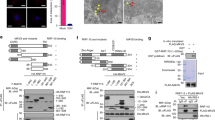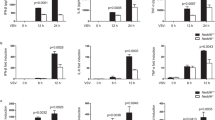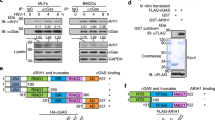Abstract
MAVS is critical in innate antiviral immunity as the sole adaptor for RIG-I-like helicases. MAVS regulation is essential for the prevention of excessive harmful immune responses. Here we identify PCBP2 as a negative regulator in MAVS-mediated signaling. Overexpression of PCBP2 abrogated cellular responses to viral infection, whereas knockdown of PCBP2 exerted the opposite effect. PCBP2 was induced after viral infection, and its interaction with MAVS led to proteasomal degradation of MAVS. PCBP2 recruited the HECT domain–containing E3 ligase AIP4 to polyubiquitinate and degrade MAVS. MAVS was degraded after viral infection in wild-type mouse embryonic fibroblasts but remained stable in AIP4-deficient (Itch−/−) mouse embryonic fibroblasts, coupled with greatly exaggerated and prolonged antiviral responses. The PCBP2-AIP4 axis defines a new signaling cascade for MAVS degradation and 'fine tuning' of antiviral innate immunity.
This is a preview of subscription content, access via your institution
Access options
Subscribe to this journal
Receive 12 print issues and online access
$209.00 per year
only $17.42 per issue
Buy this article
- Purchase on Springer Link
- Instant access to full article PDF
Prices may be subject to local taxes which are calculated during checkout







Similar content being viewed by others
References
Kumagai, Y., Takeuchi, O. & Akira, S. Pathogen recognition by innate receptors. J. Infect. Chemother. 14, 86–92 (2008).
Gitlin, L. et al. Essential role of mda-5 in type I IFN responses to polyriboinosinic:polyribocytidylic acid and encephalomyocarditis picornavirus. Proc. Natl. Acad. Sci. USA 103, 8459–8464 (2006).
Kato, H. et al. Cell type-specific involvement of RIG-I in antiviral response. Immunity 23, 19–28 (2005).
Kato, H. et al. Differential roles of MDA5 and RIG-I helicases in the recognition of RNA viruses. Nature 441, 101–105 (2006).
Kawai, T. et al. IPS-1, an adaptor triggering RIG-I- and Mda5-mediated type I interferon induction. Nat. Immunol. 6, 981–988 (2005).
Meylan, E. et al. Cardif is an adaptor protein in the RIG-I antiviral pathway and is targeted by hepatitis C virus. Nature 437, 1167–1172 (2005).
Seth, R.B., Sun, L., Ea, C.K. & Chen, Z.J. Identification and characterization of MAVS, a mitochondrial antiviral signaling protein that activates NF-κB and IRF3. Cell 122, 669–682 (2005).
Xu, L.G. et al. VISA is an adapter protein required for virus-triggered IFN-β signaling. Mol. Cell 19, 727–740 (2005).
Bhoj, V.G. & Chen, Z.J. Ubiquitylation in innate and adaptive immunity. Nature 458, 430–437 (2009).
Pickart, C.M. Mechanisms underlying ubiquitination. Annu. Rev. Biochem. 70, 503–533 (2001).
Glickman, M.H. & Ciechanover, A. The ubiquitin-proteasome proteolytic pathway: destruction for the sake of construction. Physiol. Rev. 82, 373–428 (2002).
Arimoto, K. et al. Negative regulation of the RIG-I signaling by the ubiquitin ligase RNF125. Proc. Natl. Acad. Sci. USA 104, 7500–7505 (2007).
Paz, S. et al. Ubiquitin-regulated recruitment of IκB kinase ε to the MAVS interferon signaling adapter. Mol. Cell. Biol. 29, 3401–3412 (2009).
Makeyev, A.V. & Liebhaber, S.A. The poly(C)-binding proteins: a multiplicity of functions and a search for mechanisms. RNA 8, 265–278 (2002).
Funke, B. et al. The mouse poly(C)-binding protein exists in multiple isoforms and interacts with several RNA-binding proteins. Nucleic Acids Res. 24, 3821–3828 (1996).
Wang, Z., Day, N., Trifillis, P. & Kiledjian, M. An mRNA stability complex functions with poly(A)-binding protein to stabilize mRNA in vitro. Mol. Cell. Biol. 19, 4552–4560 (1999).
Bedard, K.M., Daijogo, S. & Semler, B.L. A nucleo-cytoplasmic SR protein functions in viral IRES-mediated translation initiation. EMBO J. 26, 459–467 (2007).
Blyn, L.B. et al. Poly(rC) binding protein 2 binds to stem-loop IV of the poliovirus RNA 5′ noncoding region: identification by automated liquid chromatography-tandem mass spectrometry. Proc. Natl. Acad. Sci. USA 93, 11115–11120 (1996).
Sean, P., Nguyen, J.H. & Semler, B.L. The linker domain of poly(rC) binding protein 2 is a major determinant in poliovirus cap-independent translation. Virology 378, 243–253 (2008).
Chen, H.I. & Sudol, M. The WW domain of Yes-associated protein binds a proline-rich ligand that differs from the consensus established for Src homology 3-binding modules. Proc. Natl. Acad. Sci. USA 92, 7819–7823 (1995).
Ingham, R.J., Gish, G. & Pawson, T. The Nedd4 family of E3 ubiquitin ligases: functional diversity within a common modular architecture. Oncogene 23, 1972–1984 (2004).
Lu, P.J., Zhou, X.Z., Shen, M. & Lu, K.P. Function of WW domains as phosphoserine- or phosphothreonine-binding modules. Science 283, 1325–1328 (1999).
Scheffner, M., Nuber, U. & Huibregtse, J.M. Protein ubiquitination involving an E1–E2-E3 enzyme ubiquitin thioester cascade. Nature 373, 81–83 (1995).
Dejgaard, K. & Leffers, H. Characterisation of the nucleic-acid-binding activity of KH domains. Different properties of different domains. Eur. J. Biochem. 241, 425–431 (1996).
Hustad, C.M. et al. Molecular genetic characterization of six recessive viable alleles of the mouse agouti locus. Genetics 140, 255–265 (1995).
Oberst, A. et al. The Nedd4-binding partner 1 (N4BP1) protein is an inhibitor of the E3 ligase Itch. Proc. Natl. Acad. Sci. USA 104, 11280–11285 (2007).
Fang, D. et al. Dysregulation of T lymphocyte function in itchy mice: a role for Itch in TH2 differentiation. Nat. Immunol. 3, 281–287 (2002).
Gao, M. et al. Jun turnover is controlled through JNK-dependent phosphorylation of the E3 ligase Itch. Science 306, 271–275 (2004).
Mueller, D.L. E3 ubiquitin ligases as T cell anergy factors. Nat. Immunol. 5, 883–890 (2004).
Heissmeyer, V. et al. Calcineurin imposes T cell unresponsiveness through targeted proteolysis of signaling proteins. Nat. Immunol. 5, 255–265 (2004).
McGill, M.A. & McGlade, C.J. Mammalian numb proteins promote Notch1 receptor ubiquitination and degradation of the Notch1 intracellular domain. J. Biol. Chem. 278, 23196–23203 (2003).
Matesic, L.E., Haines, D.C., Copeland, N.G. & Jenkins, N.A. Itch genetically interacts with Notch1 in a mouse autoimmune disease model. Hum. Mol. Genet. 15, 3485–3497 (2006).
Chang, L. et al. The E3 ubiquitin ligase itch couples JNK activation to TNFα-induced cell death by inducing c-FLIP(L) turnover. Cell 124, 601–613 (2006).
Shembade, N. et al. The E3 ligase Itch negatively regulates inflammatory signaling pathways by controlling the function of the ubiquitin-editing enzyme A20. Nat. Immunol. 9, 254–262 (2008).
Melino, G. et al. Itch: a HECT-type E3 ligase regulating immunity, skin and cancer. Cell Death Differ. 15, 1103–1112 (2008).
Shearwin-Whyatt, L., Dalton, H.E., Foot, N. & Kumar, S. Regulation of functional diversity within the Nedd4 family by accessory and adaptor proteins. Bioessays 28, 617–628 (2006).
Sun, W. et al. ERIS, an endoplasmic reticulum IFN stimulator, activates innate immune signaling through dimerization. Proc. Natl. Acad. Sci. USA 106, 8653–8658 (2009).
Jiang, Z. et al. CD14 is required for MyD88-independent LPS signaling. Nat. Immunol. 6, 565–570 (2005).
Wegierski, T., Hill, K., Schaefer, M. & Walz, G. The HECT ubiquitin ligase AIP4 regulates the cell surface expression of select TRP channels. EMBO J. 25, 5659–5669 (2006).
Acknowledgements
We thank D. Chen and D. Gao (Peking University) for technical assistance and the 293 cDNA library for yeast two-hybrid screening; Z. Chen (University of Texas Southwestern Medical Center) for MAVS chimera expression vectors; E. Harhaj (University of Miami) for Itch−/− MEFs; Q. Chen (Nankai University) for antibody to Bcl-xL (anti-Bcl-xL); H. Shu (Wuhan University) for HA-UB(K48) and HA-UB(K63) (plasmids encoding ubiquitin-K48 and ubiquitin-K63); C. Zheng (Wuhan University) for SeV; and C. Wang (Shanghai Institutes for Biological Sciences) for green fluorescent protein (GFP)-tagged NDV. Supported by the National Natural Science Foundation of China (30772024, 30721064), the National Basic Research Program of China (2007CB914502) and the Key Project of the Chinese Ministry of Education (108002).
Author information
Authors and Affiliations
Contributions
Z.J. designed research; F.Y., H.S., X.Z., W.S. and S.L. did research; Z.Z. contributed new reagents and analytical tools; F.Y., H.S., X.Z., W.S. and Z.J. analyzed data; and F.Y., X.Z. and Z.J. wrote the paper.
Corresponding author
Supplementary information
Supplementary Text and Figures
Supplementary Figures 1–12 and Supplementary Tables 1–2 (PDF 756 kb)
Rights and permissions
About this article
Cite this article
You, F., Sun, H., Zhou, X. et al. PCBP2 mediates degradation of the adaptor MAVS via the HECT ubiquitin ligase AIP4. Nat Immunol 10, 1300–1308 (2009). https://doi.org/10.1038/ni.1815
Received:
Accepted:
Published:
Issue Date:
DOI: https://doi.org/10.1038/ni.1815
This article is cited by
-
Effect of RNA-binding proteins on osteogenic differentiation of bone marrow mesenchymal stem cells
Molecular and Cellular Biochemistry (2024)
-
Ubiquitin ligase enzymes and de-ubiquitinating enzymes regulate innate immunity in the TLR, NLR, RLR, and cGAS-STING pathways
Immunologic Research (2023)
-
MST4 negatively regulates type I interferons production via targeting MAVS-mediated pathway
Cell Communication and Signaling (2022)
-
Early innate immune response triggered by the human respiratory syncytial virus and its regulation by ubiquitination/deubiquitination processes
Journal of Biomedical Science (2022)
-
PCBP2 maintains antiviral signaling homeostasis by regulating cGAS enzymatic activity via antagonizing its condensation
Nature Communications (2022)



